Fortunate to have learnt the first as well as the last thevaram of Thirugnanasambandar. (One of the Naalvar Saints) The first Thodudauya seviyan was sung on the banks of the Brahmapureeswarar temple at Sirkali when the saint was barely 4 years. The last Kaadhalaagi Kasindhu was sung at a place now called Achalpuram , known as Naloor Perumanam in the times of the saint. A full circle of divine devotion.
Taking a road which leads to Achalpuram from Kollidam, just beyond the town of Chidambaram, we got entangled in a procession, it was a religious procession with people carrying pots on their head and a few men dressed up like Lord Shiva were walking along.
Finally when we reached the Gopura Vaasal the sun was high up and it was a blazing hot day, in the month of June. While Senthil parked the car, amma and I slowly walked towards the entrance, admiring the imposing Raja Gopuram.

A local on a two wheeler stopped and asked us whether we had come to witness the two- day Utsavam which was to commence the following day. With visible pride, he went on to describe how vibrant and grand the Utsavam would be, adding that his family was involved in the Anna Dhaanam (distribution of food to all devotees) for the Utsavam. Away from the bustling Chennai Metro, the people here seemed to be far more friendly and also curious to know about the whereabouts of newcomers. By then Senthil had joined us and we entered the portals hearing the strains of Thevaram being chanted by a group of Student Odhuvars with their Guru. The Mandapam just as we entered had the entire life history of Thirugnanasambandar painted beautifully on the ceiling. Made note and decided that I would take pictures later. We decided to complete our darshan of the moolavar Sivaloga Thyagar. As we entered the inner mandapam, we noticed that the premises were being washed by a group of devotees. A gentleman supervising them kindly cautioned us to step carefully, as the floor was slippery. The Shiva Linga Murthy was majestic, and a priest appeared from within, moving briskly—everyone seemed engrossed in the preparations for the upcoming Utsavam. For a moment, I felt a twinge of guilt, wondering if our visit was disrupting the rhythm of their sacred chores.

Nevertheless he performed the Deepa Aradhanai and after that we slowly came outside, did a pradikshanam pausing to see the Naalvar sanidhis as well as the other Goshta Murthies. The one which housed Nardhana Ganapathy interestingly had a gopuram sculpted above the Murthy. Not sure in which period that was sculpted. Achalpuram temple had several inscriptions. I had read up that this temple was built during the time of the Imperial Cholas and the inscriptions speak of donations made during the reigns of Rajendra 1, Kulothunga 1 and Raja Raja 3.
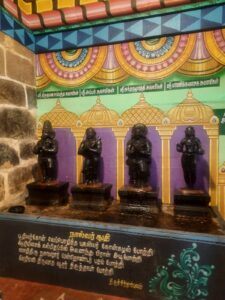


After completing the circumambulation, we reached the outer pillared mandapam, where Thirugnanasambandar and his consort, Stotra Poornambigai, were enshrined. Behind the sannidhi was a striking depiction of the saint attaining Mukthi—hand in hand with his wife—as a host of devotees followed them toward a blazing fire. It is well known among Saivites that Thirugnanasambandar was married to Stotra Poornambigai at this very temple, making it a site of profound spiritual and historical significance.
Legend goes that Thirugnanasambandar’s father Sivapada Hrudayar insisted that Sambandar be married as per the tradition of the times. Although Sambandar was unwilling, he agreed to marry Sokkiyaar from Nallur, a neighbouring village, daughter of Nambiandaar Nambi. Thiruneela Nakka Nayanaar, one among the 63 Nayanmars conducted their wedding. Just after their wedding, the divine couple entered the temple at Naloor Perumanam—present-day Achalpuram. It was then that Thirugnanasambandar sang the Thevaram, ‘Kaloor Perumanam Venda Kazhumalam’. With that, he expressed his wish to attain Mukthi and merge with the Supreme. Sokkiyaar, another ardent devotee of Shiva, echoed his sentiments. Perhaps it was all divinely ordained—his life on earth lasted a mere sixteen years, yet it was a life that could rival centuries in depth and devotion, filled with miraculous deeds and over a thousand sacred Padhigams to his name.
A fire engulfed the Sanctum Sanctorum and Sambandar with his wife, who later came to be known as Stotra Poornambigai, along with both their family members, Thiruneela nakka Nayanar, Muruga Nayanar, Neelakanta Yazhpanar walked along with the couple towards the fire. Sambandar sang his last and final Thevaram, the soulful Kadhalaagi Kasindhu each stanza ending with Namasivayave and merged with the divine.
It is said that the other people in the vicinity fled in fear seeing the fire. Nandi appeared before the residents of this town, instructed them to take a dip in the Panchakshara Theertham (which is there right in front) and come into the temple. Legend goes that Goddess Parvathi appeared with the sacred ash, Viboothi and lovingly distributed to all the people present. Finally, every resident of Achalpuram attained Mukthi by entering the fire that day.
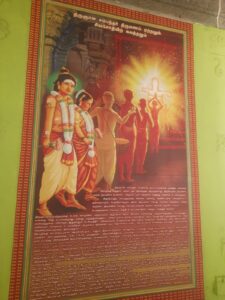
Having had darshan at the Thirugnanasambandar Sannidhi and recalled this profound legend, we walked towards the Ambal Sannidhi. The sun was relentless by then, thankfully amma was wearing her temple socks bought from Happy Feet India. The outer praharam was expansive with separate shrines for Vinayagar, Murugan and his consorts as well as the Ambal Sannidhi, called Thiruneetru Umai Ammai. Interestingly, only vibhudhi or sacred ash is given as prasadam instead of Kungumam. The priest also handed us fruits and glass bangles as blessings. I wore the bangles for the rest of the temple visit—and now keep them as a cherished memento of that day.



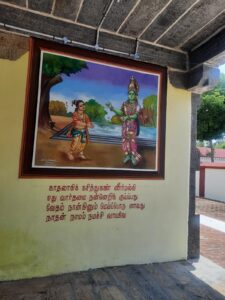





Achalpuram is also the place where Shiva gave his Kailash darshan to Lord Murugan as well as Sage Vasishta, Parasharar, Brigu and Jamadagni, so I had read somewhere that 3 times Pradhikshina is recommended but since it was so hot, I was unable to do so.
This sacred temple also houses a separate shrine for Rana Vimochanar, where devotees firmly believe that sincere prayers can help clear debts and financial burdens. An extraordinary legend associated with this temple is that of the sage Kakabhujangar, who, overwhelmed by the sanctity of the place, is said to have walked on his head—believing it too holy to let his feet touch the ground. Reminded me of Kaaraikaal Ammaiyaar who was part of the 63 Nayanmaars who also walked on her head to reach Thiruvaalangaadu as well as Mount Kailash as both these places were too sacred for her feet.
The Odhuvars were still singing with fervour, their voices rising in devotional unison. As their chants echoed through the mandapam, I began photographing the exquisite ceiling paintings that depicted the life of Thirugnanasambandar. Then, drawn by the atmosphere, I sat down facing Sivaloga Thyagar and sang softly—first Kaloor Perumanam, followed by Kaadhalaagi Kasindhu Kaneer Malgi—this is why I had insisted on this trip, to sing the thevarams which I had learnt at the very same place it was originally sung.
The Mukthi of Thirugnanasambandar is commemorated each year as an Utsavam on Vaikāsi Moolam day. The celebrations begin with the Upanayanam ceremony (the thread ceremony) for the young saint, followed by his wedding. The Utsavar deities are then taken in a grand procession around the town. Around 4 AM, a sacred fire is lit inside the Garba Griham, and the Utsavar deities are led into the sanctum—re-enacting that divine moment of Mukthi.
As we walked back to the car, I took a quick video of the entrance and just noticed that the mandapam adjacent was named Sokkiyaar Nilayam.
I turned to Amma and said with quiet awe, ‘We have walked on the same sacred soil that Thirugnanasambandar and hundreds of Sivan adiyars once walked.
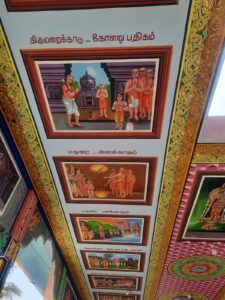
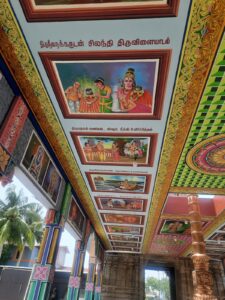
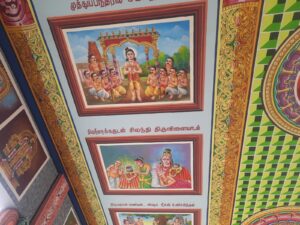
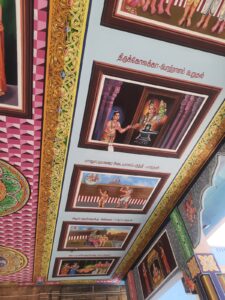
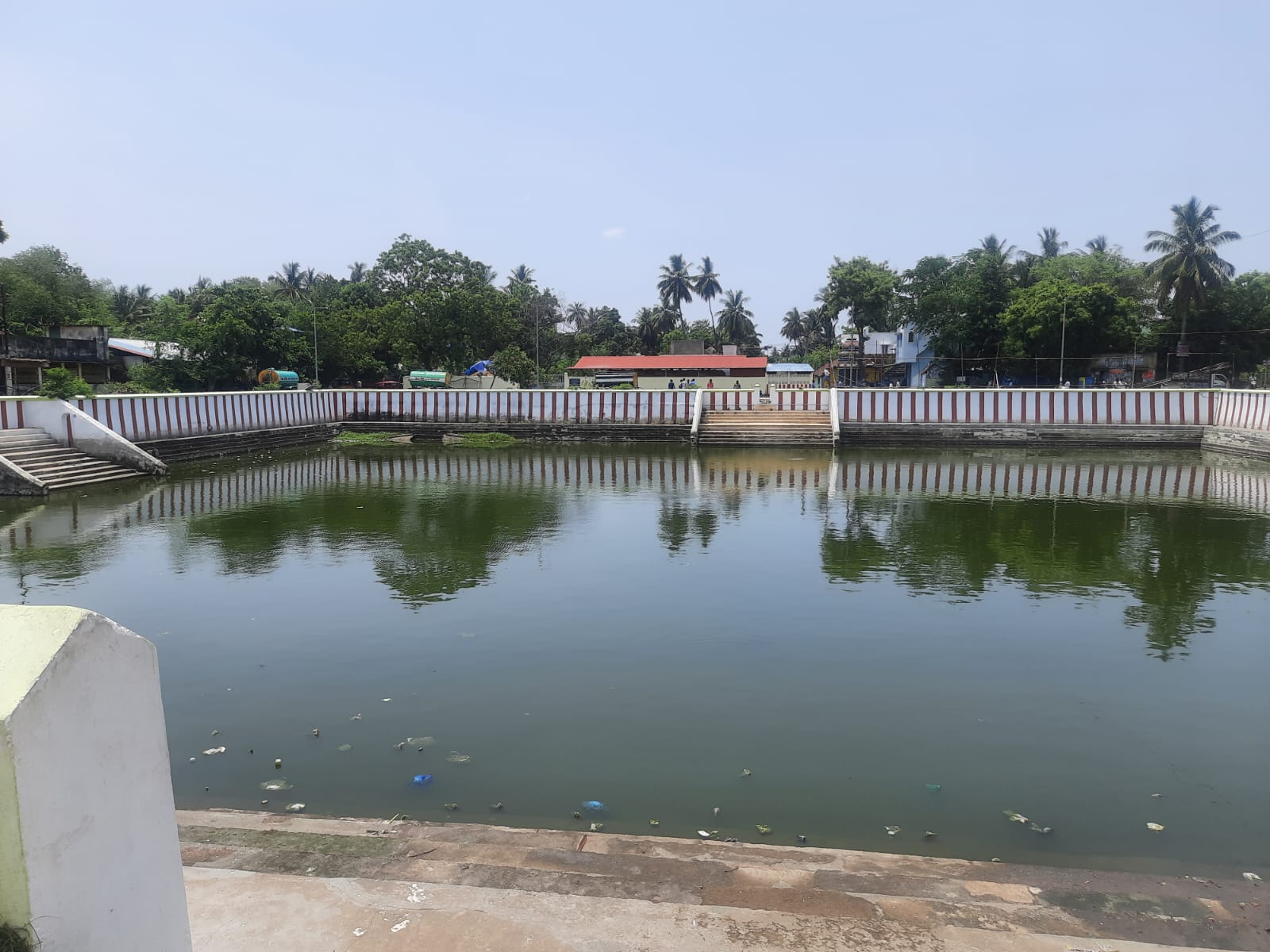
Very interesting narration of Chola built temple promoting Bhakthi Movement. Photos are excellent. The Achalapuram trip captures well the young saint’s spiritual outpourings on Shiva. Kudos. Keep exploring and recording the thousand years of Tamil life depicted in mesmerizing villages.
What a soulful temple! I read and watched the videos and images more than once so that I can take in the intricate crochet of your beautiful words that enhanced my reading experience Megu ! Wish I could visit the temple soon.
Fantastic description giving a complete picturesque view as if we are also present during this religious cum historical values. No words to express adequately in thanking.🙌
Very interesting read meghu
Very interesting to know about Thirugnanasambandar and his connection to Achalpuram temple.
Surprising it is a very well kept and the painting work is amazing.
Very nice information and explanations Megalai
Very interesting. I read twice.
Pics taken and written in detail 👏👏👏👏
Hi Meghu, we are also blessed to your divine visit to Achal puram (Naloor Perumanam). Your article is so beautiful and gave a clear picture of the temple. Thank you.
Kaathalagi kasindu was one of Mama’s favourite Thevarams. Niru has danced for it. Her Vaadhiyar used to sing it with just the right emotion in his voice. It used to be a great experience for us.
Beautiful narration and recollections of legends Meku! Felt like I went on this tour with you. Singing the thevarams at the very place it originated must have felt surreal. 🙏
Very nicely written Megu and a fine tribute to this well maintained temple 👌👌👌
Good naration. really superb
Thanks for taking us on a tour of Achalpuram temple and immersing us in the divine experience.
Lots of interesting info. Never knew that kadhalagi kasindhu was his last hymn and it was sung at Achalpuram. Thanks for sharing
Written beautifully and through this blog it seems like I have walked through the temple experiencing the varied elements from divinity to everything.
Thanks for making us to ” travel with you” through your blog .
Photos add colours to your narration .
Now I realise we miss so many places right at our door step and always wish I must go here and there
Just finished reading the post .I have no words to express my feelings .I also felt like merging with the divine .
Excellent writeup of this beautiful Hindu temple located in South India. Thank you for capturing the beauty of the temple, educating us about the history of the ancient hindu sages, the videos and photographs that transport us to this divine location. Absolutely divine 🙏.
Dear Megha, Thank you for sharing your experience at the Achalpuram Temple. Your blogs are always a divine treat as I am simply transported to the temple through your words. I am mesmerized by your ability to articulate your experience with profound devotion and fine historic details. You are a blessing!
Keep these articles coming! Much love.
Very nicely written and very interesting to read 🙏
For some reason I believe that your’s is the kind of faith that can move mountains .
Not surprisingly , ‘ bhakti ‘ is the flavor used to paint the landscape of your detailed narrative.
Despite the temple and it’s premises being impressive, your description of them has imparted a glorious glow .
For the devotees, your videos have brought the Gods right into their homes !
Well done , Megs !
You took me along yet again with your vivid description. Wonderful to learn such history.
Keep writing.
Thank you so much Megha for sharing so beautifully your temple visit.
Very interesting and well explained…lovely pictures
I truly enjoy your words and through your descriptions I feel I am seeing the temple in front of me…certainly visiting this temple soon.
Keep writing and sharing
Beautiful explanation Aka,
I want to go there and absorb the energy too.
Anyone can guide me?